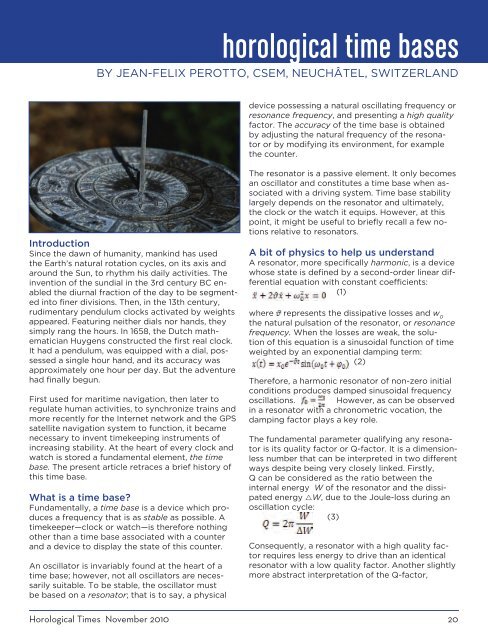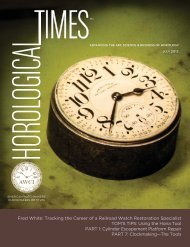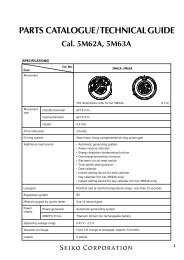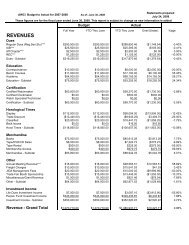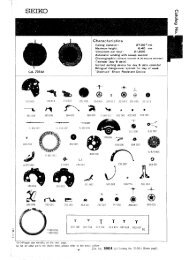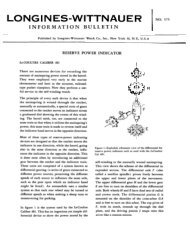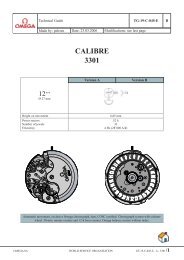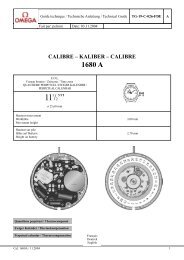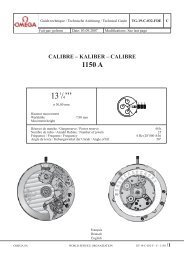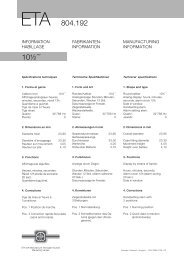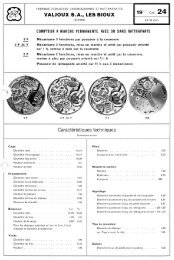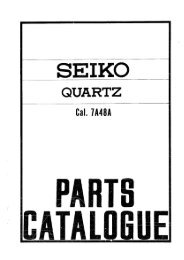PDF Version - The American Watchmakers-Clockmakers Institute
PDF Version - The American Watchmakers-Clockmakers Institute
PDF Version - The American Watchmakers-Clockmakers Institute
You also want an ePaper? Increase the reach of your titles
YUMPU automatically turns print PDFs into web optimized ePapers that Google loves.
horological time bases<br />
by Jean-Felix Perotto, CSEM, Neuchâtel, Switzerland<br />
device possessing a natural oscillating frequency or<br />
resonance frequency, and presenting a high quality<br />
factor. <strong>The</strong> accuracy of the time base is obtained<br />
by adjusting the natural frequency of the resonator<br />
or by modifying its environment, for example<br />
the counter.<br />
Introduction<br />
Since the dawn of humanity, mankind has used<br />
the Earth’s natural rotation cycles, on its axis and<br />
around the Sun, to rhythm his daily activities. <strong>The</strong><br />
invention of the sundial in the 3rd century BC enabled<br />
the diurnal fraction of the day to be segmented<br />
into finer divisions. <strong>The</strong>n, in the 13th century,<br />
rudimentary pendulum clocks activated by weights<br />
appeared. Featuring neither dials nor hands, they<br />
simply rang the hours. In 1658, the Dutch mathematician<br />
Huygens constructed the first real clock.<br />
It had a pendulum, was equipped with a dial, possessed<br />
a single hour hand, and its accuracy was<br />
approximately one hour per day. But the adventure<br />
had finally begun.<br />
First used for maritime navigation, then later to<br />
regulate human activities, to synchronize trains and<br />
more recently for the Internet network and the GPS<br />
satellite navigation system to function, it became<br />
necessary to invent timekeeping instruments of<br />
increasing stability. At the heart of every clock and<br />
watch is stored a fundamental element, the time<br />
base. <strong>The</strong> present article retraces a brief history of<br />
this time base.<br />
What is a time base<br />
Fundamentally, a time base is a device which produces<br />
a frequency that is as stable as possible. A<br />
timekeeper—clock or watch—is therefore nothing<br />
other than a time base associated with a counter<br />
and a device to display the state of this counter.<br />
An oscillator is invariably found at the heart of a<br />
time base; however, not all oscillators are necessarily<br />
suitable. To be stable, the oscillator must<br />
be based on a resonator; that is to say, a physical<br />
<strong>The</strong> resonator is a passive element. It only becomes<br />
an oscillator and constitutes a time base when associated<br />
with a driving system. Time base stability<br />
largely depends on the resonator and ultimately,<br />
the clock or the watch it equips. However, at this<br />
point, it might be useful to briefly recall a few notions<br />
relative to resonators.<br />
A bit of physics to help us understand<br />
A resonator, more specifically harmonic, is a device<br />
whose state is defined by a second-order linear differential<br />
equation with constant coefficients:<br />
(1)<br />
where represents the dissipative losses and w 0<br />
the natural pulsation of the resonator, or resonance<br />
frequency. When the losses are weak, the solution<br />
of this equation is a sinusoidal function of time<br />
weighted by an exponential damping term:<br />
(2)<br />
<strong>The</strong>refore, a harmonic resonator of non-zero initial<br />
conditions produces damped sinusoidal frequency<br />
oscillations.<br />
However, as can be observed<br />
in a resonator with a chronometric vocation, the<br />
damping factor plays a key role.<br />
<strong>The</strong> fundamental parameter qualifying any resonator<br />
is its quality factor or Q-factor. It is a dimensionless<br />
number that can be interpreted in two different<br />
ways despite being very closely linked. Firstly,<br />
Q can be considered as the ratio between the<br />
internal energy W of the resonator and the dissipated<br />
energy rW, due to the Joule-loss during an<br />
oscillation cycle:<br />
(3)<br />
Consequently, a resonator with a high quality factor<br />
requires less energy to drive than an identical<br />
resonator with a low quality factor. Another slightly<br />
more abstract interpretation of the Q-factor,<br />
Horological Times November 2010 20


